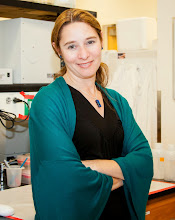In a previous post I introduced the idea of telling stories within a scientific talk - using techniques such as plot, character development, climax, and resolution to make science (and scientists!) come alive.
Today I want to highlight a recent example of a terrific scientist who also tells a great story. A few months ago I attended a talk by Dr. Douglas Green from St. Jude Children’s Research Hospital. Doug studies the intricacies of cell death signaling, which can be a bit of a dry subject even to the aficionado. This was a lunchtime seminar full of cancer researchers, neuroscientists…in short, serious researchers prepared to dive in to the topic. And then Doug told us a story, complete with characters, conflict, and (perhaps) resolution.
This was no bedtime story, though. Embedded within the story was some serious science, as two groups of researchers presented different models for how specific cell death signaling molecules interact to promote cell death or survival. Doug described the tension at meetings as each group presented evidence for their model and tried to discredit the other side. After hearing about the conflict I was eager for a resolution-which group was right? He then led us through data from his lab that, depending on the circumstances, partially supported each model, and told of the triumph as each research group in the conflict gloated and sulked in turn.
At the end of the hour I had a deeper understanding of cell death signaling without the usual post-talk sleepiness I often feel. Instead, I was energized, having learned a lot and been entertained at the same time. Even in a room full of scientists, it’s best to tell a story. Have you heard great examples of scientists that use storytelling elements? Share your story with us!
This blog post also appears on Qualia, part of AAAS MemberCentral.

Alli,
ReplyDeleteOn a related note, thought you and your readers may find this webinar interesting: Storytelling: A Tool for Effective Communication.
Thanks Todd! I missed the webinar today (that whole "work" thing, as usual), so I'll see if I can watch it post-hoc.
ReplyDelete